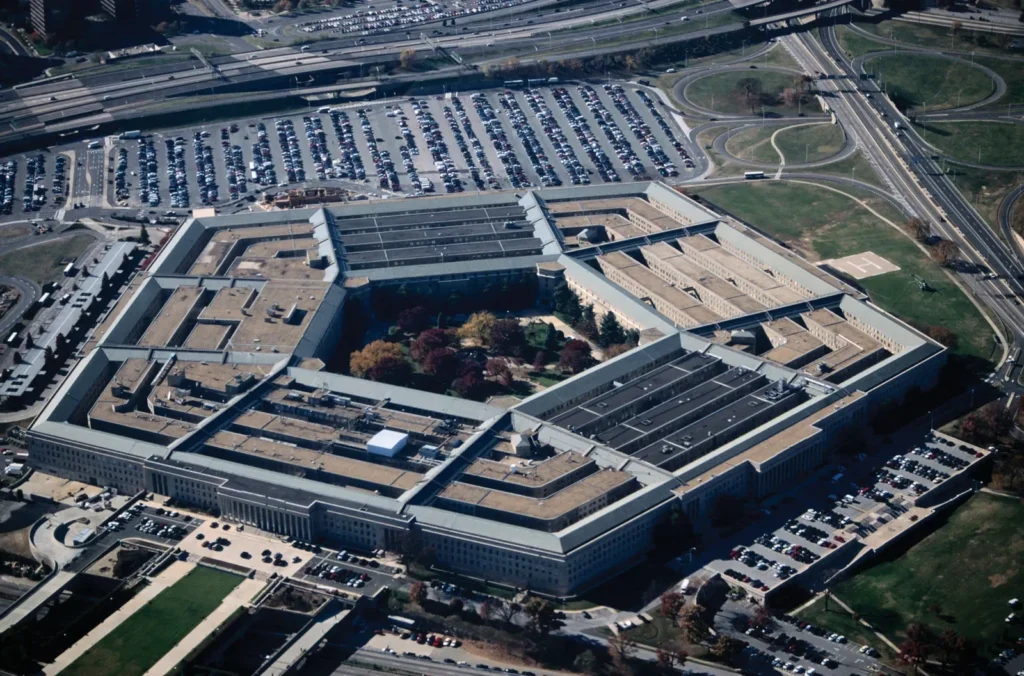How The Pentagon Became The World’s Most Secure Building: A Guide
The Pentagon. Just the name itself conjures images of immense power and, well, secrets. It’s the headquarters of the United States Department of Defense, a building that houses the heads of the Army, Navy, Marines, Air Force, National Guard, and Coast Guard. You’ll find most of our four-star generals there, pretty much all classified military secrets, and, apparently, an inexplicably large archive of UFO videos. Oh, and one Dunkin’ Donuts.
Now, if you’re the United States, it’s very much in your best interest for this building to not explode. That would, you know, leave Arlington with only fifteen remaining Dunkin’ Donuts, which would be a tragedy, wouldn’t it? Given the stakes, it shouldn’t come as a surprise that the Pentagon is considered one of the most secure buildings on the planet. But then again, it kind of just looks like a normal office building. So, what exactly does the Pentagon do to keep all five of its sides intact? Let’s take a look.
From Hasty Construction to a Fortified Fortress
When the Pentagon was first built, way back when, security wasn’t exactly the top priority. It was constructed as quickly and as cheaply as possible, primarily to speed up the effort of, shall we say, defeating certain adversaries in wartime. High quality steel was needed for other things, so the building itself was put up with efficiency in mind. At the time, perhaps the thinking was, “It’s fine, surely no one will invent terrorism and try to blow up the Pentagon.” A rather innocent thought, in retrospect.
Fast forward about five decades to 1990, and the US Department of Defense found itself under attack, not by terrorists, but by asbestos. This required tearing down a whole wedge of the Pentagon and rebuilding it from scratch. This was a massive undertaking. So, the DoD, being pragmatic, said, “Hey, if we’re going to rebuild this part of the Pentagon from scratch, let’s build it with experimental, world class anti terrorism measures, just for fun.” And so they did, completing this particular section in 2001. A rather unfortunate, or perhaps fortunate, timing, as al Qaeda decided to take it for a test run shortly thereafter.
- Initial Construction: Built quickly and cheaply with less focus on security due to wartime priorities.
- Asbestos Renovation Catalyst: A major asbestos problem in 1990 necessitated tearing down and rebuilding a section.
- Experimental Security: This rebuild incorporated advanced, experimental anti terrorism measures.
- Timely Completion: The renovated section was completed just before the 9/11 attacks in 2001.
The 9/11 Test: Wedge One’s Resilience
Fortunately enough, and this is truly a remarkable twist of fate, the plane that crashed into the Pentagon on September 11, 2001, just so happened to crash into that special anti terrorism wedge. Which, if you’re trying to do terrorism, is probably the last wedge you’d want to hit. The outer walls of this section, known as Wedge One, had been reinforced with robust steel beams. And here’s the clever part: a Kevlar mesh was stretched between those beams. This wasn’t just for show; it prevented the destroyed portions of the walls from becoming deadly shrapnel, which could have caused even more casualties inside.
Every single window in that renovated section was made out of an inch and a half thick pane of explosive resistant glass, each weighing a hefty 500 pounds. And none of them, not a single one, managed to shatter, even though they were literally hit by an airplane. The DoD, looking at this, probably had a collective “huh” moment and said, “Well, we should probably put that stuff in all the other parts of the Pentagon.” And thus, Project Phoenix was born.
- Fortuitous Impact: The 9/11 plane struck the newly reinforced Wedge One.
- Reinforced Walls: Steel beams with a Kevlar mesh prevented shrapnel.
- Explosive Resistant Glass: 1.5 inch thick, 500 pound windows remained intact despite the impact.
- Catalyst for Project Phoenix: The success of Wedge One’s defenses led to a full scale renovation of the rest of the building.
Project Phoenix: Securing the Perimeter and Beyond
Project Phoenix wasn’t just about renovating the building itself, though that was a huge part of it. This massive effort to transform the Pentagon into one of the world’s most secure buildings largely focused on the area surrounding it. You see, two of the Pentagon’s biggest vulnerabilities, at the time, were quite literally right there, almost in plain sight.
For one, there was a metro station that fed directly into the area under the Pentagon. That’s a pretty obvious access point, isn’t it? So, that entrance was promptly closed. The idea was to keep all access points to the Pentagon strictly above ground, where they could be monitored and controlled. The other problem was right there on Route 110. At the time, this unrestricted highway passed directly next to the Pentagon. This meant that vehicles carrying, well, anything scary, like bombs or, dare I say, clowns, could get within meters of the building without undergoing any kind of security screening. Not ideal, if you think about it.
To fix this rather glaring issue, the Department of Defense had the entire highway rerouted. Yes, the whole thing. It was moved through the Pentagon’s north parking lot, effectively creating a kind of force field around the building. Now, no bombs or clowns, or anything else for that matter, can enter that zone without passing through a security checkpoint. It’s a pretty ingenious solution, if a bit drastic.
- Comprehensive Renovation: Project Phoenix extended security upgrades to the entire Pentagon building.
- Metro Station Closure: An underground metro entrance directly under the Pentagon was closed to centralize access above ground.
- Route 110 Rerouting: A highway passing close to the Pentagon was rerouted through a security checkpoint, creating a secure perimeter.
- Enhanced Perimeter Control: These measures established a secure zone around the building, controlling all vehicle and pedestrian access.
Above the Ground: Air Defense for the Capital
So, that covers the underground and the above ground, but what about the above above ground? You know, the sky? Well, that’s where everyone’s favorite integrated air defense system, the National Capital Region Integrated Air Defense System, comes into play. Across the river, there’s a whole network of radars, cameras, and other sensors. These aren’t just for show; they constantly watch the airspace over Washington D.C. and much of Virginia and Maryland.
If any aircraft enters that restricted space that isn’t supposed to be there, this airbase will, quite dramatically, shine a laser at the cockpit. Any trained pilot, it’s believed, will recognize this as a very clear signal: “Please turn around before we replace this laser with something more explosive.” Assuming they don’t turn around, the air defense system can then use what they refer to as an “engagement asset.” Now, that kind of sounds like a beautiful diamond ring, doesn’t it? But it’s actually one of several types of missiles. A rather stark contrast, I think you’ll agree.
- National Capital Region Integrated Air Defense System: A comprehensive system monitoring airspace over D.C. and surrounding areas.
- Detection Systems: Utilizes radars, cameras, and sensors to identify unauthorized aircraft.
- Warning Protocol: Unauthorized aircraft receive a laser warning to turn around.
- Engagement Assets: If warnings are ignored, missile systems are available for intervention.
The Mailroom: Stopping Threats Before They Arrive
Now, all of these external security features aren’t worth much if someone manages to get something dangerous, like, let’s say, a small clown holding a bomb, inside the building itself. And that doesn’t seem like it should be all that hard, given that you can just, well, ship stuff there. I mean, here’s the mailing address for the Secretary of Defense, go crazy. The Pentagon receives thousands of shipments every single day. So, how on earth do they stop your mail bound bomb clown from planting his bomb in the Pentagon?
Well, when you ship something to the Pentagon, it doesn’t actually go to the Pentagon. No, it goes somewhere else entirely: the Pentagon’s Remote Delivery Facility, or RDF. This facility was one of the most major renovations of Project Phoenix. One of the Pentagon’s parking lots was literally torn out and replaced with this dedicated mail sorting facility. It has 38 loading docks and is nearly as big as the Pentagon itself. It’s a massive operation.
After arriving at the RDF, each truck is thoroughly searched with mirrors, and then examined by canine teams specifically trained to check for explosives. The drivers themselves then go through a metal detector before they’re even allowed to open the truck. And finally, everything inside the truck is thoroughly X-rayed. Once the team has, presumably, removed the bomb from your clown, then the neutralized clown can be sent through a secure tunnel directly to the Pentagon itself, to do whatever it needs to do there without hurting anyone.
- Remote Delivery Facility (RDF): All mail and shipments are rerouted to a large, dedicated off-site facility.
- Multi-Layered Screening: Trucks are searched with mirrors, canine teams check for explosives, drivers pass through metal detectors, and all contents are X-rayed.
- Secure Delivery: Screened items are sent via a secure tunnel to the Pentagon.
- Pre-Emptive Threat Neutralization: This system aims to detect and neutralize threats before they ever reach the main building.
The Unseen Bypass: A Bunny’s Tale
So, there you go: successfully infiltrating the Pentagon in the modern age is, by all accounts, all but impossible. That is, unless, you’re a bunny. Yes, a bunny. Apparently, in February of 2022, a bunny somehow managed to bypass every single security feature that I just described without being detected. It possibly, just possibly, proved that this whole thing doesn’t matter and was just a giant waste of money. Or, perhaps, it was just a very, very clever bunny. One might wonder, you know, what secrets that rabbit might have uncovered. It certainly adds a bit of, shall we say, intellectual hesitation to the idea of absolute infallibility.
- Near Impenetrable Security: The Pentagon’s multi-layered defenses make infiltration extremely difficult.
- The Bunny Incident: A notable, humorous incident in 2022 where a bunny bypassed all security, raising questions about the system’s absolute perfection.
The Pentagon’s Evolution: A Secure Legacy
We’ve explored the remarkable transformation of the Pentagon from a hastily built wartime structure to one of the world’s most secure buildings. This journey began with an unexpected catalyst—asbestos—leading to the initial reinforcement of Wedge One, which famously withstood the 9/11 attack. This success spurred Project Phoenix, a massive undertaking that extended advanced security measures throughout the building and its immediate surroundings, including rerouting highways and securing access points. Beyond the physical structure, a sophisticated air defense system protects the skies, while a dedicated Remote Delivery Facility meticulously screens all incoming mail and shipments. Despite these extensive measures, a curious incident involving a bunny reminds us that even the most advanced security systems may have their, shall we say, unexpected vulnerabilities.
Key Takeaways
- The Pentagon’s security evolution was largely driven by the 1990 asbestos removal and the subsequent 9/11 attack on the newly reinforced Wedge One.
- Project Phoenix implemented comprehensive security upgrades, including structural reinforcements, explosive-resistant glass, and the rerouting of external access points like roads and metro entrances.
- Airspace around the Pentagon is protected by a sophisticated integrated air defense system with radar, sensors, laser warnings, and missile capabilities.
- All incoming mail and deliveries are screened off-site at the Remote Delivery Facility (RDF) using multiple layers of inspection before reaching the main building.
- While designed to be virtually impenetrable, the unexpected bypass by a bunny highlights that no security system is absolutely foolproof.





